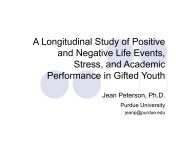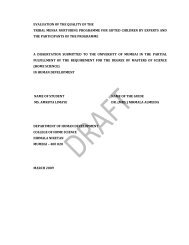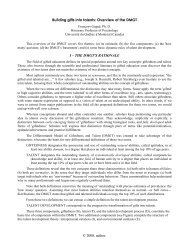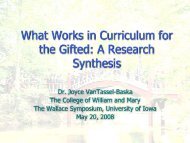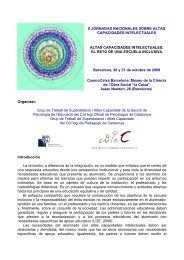Tst gifted 08 - Templetonfellows.org
Tst gifted 08 - Templetonfellows.org
Tst gifted 08 - Templetonfellows.org
You also want an ePaper? Increase the reach of your titles
YUMPU automatically turns print PDFs into web optimized ePapers that Google loves.
TESTOSTERONE<br />
AND<br />
COGNITION<br />
the contribution to the neurobiology<br />
of <strong>gifted</strong>ness<br />
DANIELA OSTATNIKOVA<br />
COMENIUS UNIVERSITY FACULTY OF MEDICINE<br />
BRATISLAVA<br />
SLOVAKIA
WHERE IS THE SITE OF<br />
INTELLIGENCE
Alternative PROgram for Gifted<br />
EducatioN in Slovakia, APROGEN<br />
The net of 27 primary schools with APROGEN classes<br />
• 600 students in Bratislava – School founded n 1998<br />
• 3000 pupils in Slovakia involved in this programme<br />
The School for Intellectually Gifted in Bratislava, Slovakia<br />
is one possible alternative for children with high academic<br />
potential
ALBERT EINSTEIN – frontal and temporal lobes studied<br />
In the left hemisphere, in<br />
area 39 there were more<br />
glial cells for every neuron in<br />
his brain.<br />
Higher density of supportive<br />
cells per neuron in certain<br />
area of the brain might<br />
indicate an increased<br />
"metabolic need" – neurons<br />
need and use more energy.
FRONTAL LOBES<br />
Grey matter amount in frontal brain regions is strongly<br />
inherited and predicts individual's IQ scores<br />
(Paul Thompson, Nature Neuroscience, 2001)<br />
MRI of 20<br />
identical twins<br />
and 20 same<br />
sex fraternal<br />
twins
...“Single „intelligence center“ such as the frontal lobe, is<br />
unlikely...“ dr. Richard Heier, 2004<br />
His study was the first to demonstrate that<br />
1) gray matter in specific regions in<br />
the brain is more related to IQ than<br />
overall size<br />
2) Only about 6% of all gray<br />
matter in the brain appears to be<br />
related to IQ<br />
3) The distribution of gray matter<br />
in humans is highly heritable.<br />
Researchers used voxel-based* morphometry<br />
in 47 normal adults to determine gray matter<br />
Volume throughout the brain which they<br />
correlated to IQ scores<br />
*Short for volume pixel, the smallest distinguishable box-shaped<br />
part of a three-dimensional image
WHAT EXACTLY MAKES A PERSON<br />
BRILLANT
NATURE as well as NURTURE<br />
(formerly seen as incompatible perspectives)<br />
GENES & ENVIRONMENT<br />
INTERACTIONIST PERSPECTIVE<br />
(interrelations between genetics & environment)<br />
HEREDITY DETERMINES ONE´S POTENTIAL<br />
BUT ENVIRONMENT DETERMINES HOW FAR ONE WILL REACH THAT<br />
POTENTIAL DURING HER OR HIS LIFETIME
HORMONES ARE MESSENGERS OF<br />
GENES<br />
PROVIDING SPECIFIC<br />
ENVIRONMENTAL EFFECT ON BRAIN
EFFECTS OF SEX STEROIDS ON<br />
NEURAL STRUCTURES<br />
SUGGESTIVE DATA HAVE ACCUMULATED<br />
LINKING TESTOSTERONE AND ESTRADIOL<br />
TO COGNITION IN HUMANS<br />
SOMATIC CHARACTERISTICS<br />
TESTOSTERONE<br />
5-α-REDUCTASE<br />
DIHYDROTESTOSTERONE<br />
AROMATASE<br />
ESTRADIOL<br />
COGNITION<br />
NEUROPROTECTIVE EFFECT<br />
PREVENTION OF CELL DEATH<br />
SYNAPTOGENESIS<br />
DENDRITIC GROWTH
Sexual dimorphisms<br />
in the rat brain.<br />
HYPOTHALAMUS<br />
ORGANIZATIONAL EFFECT<br />
The sexually dimorphic nucleus of the preoptic area (SDN-POA) is larger in male rats (a) than<br />
in females (b) because the testes secrete testosterone during the sensitive period. After that<br />
time, testosterone has little effect on SDN-POA volume.<br />
Sexual dimorphisms<br />
in the rat brain.<br />
AMYGDALA<br />
ACTIVATIONAL EFFECT<br />
In contrast, the volume of the rat posterodorsal medial amygdala (MePD), which is about 1.5<br />
times larger in males (c) than in females (d), retains its responsiveness to testosterone<br />
throughout life. All scale bars = 250 µm.
TESTOSTERONE LEVELS DURING ONTOGENESIS IN BOYS<br />
Plasma testosterone (nmol/L)<br />
30<br />
15<br />
foetus childhood puberty adulthood senescence<br />
ORGANIZATION<br />
ACTIVATION<br />
1. 2. 3. 1 10 17 40 60 80<br />
trimester<br />
age in years
ORGANIZATIONAL EFFECT OF TESTOSTERONE<br />
ON HUMAN INTELLIGENCE<br />
+<br />
RH<br />
‣ GIFTEDNESS<br />
mathematical<br />
musical<br />
spatial<br />
↑ TST<br />
‣ ANOMALOUS<br />
DOMINANCE<br />
handedness<br />
speech<br />
centres<br />
_<br />
LH<br />
‣IMMUNE DISORDERS<br />
(Geschwind, Behan, Galaburda; 1985, 1987)
Testosterone in nmol/L<br />
0,050<br />
0,045<br />
0,040<br />
0,035<br />
0,030<br />
0,025<br />
0,020<br />
0,015<br />
0,010<br />
0,005<br />
<strong>gifted</strong><br />
control<br />
0,000<br />
6 years 7 years 8 years 9 years<br />
SALIVARY TESTOSTERONE LEVELS IN CHILDREN<br />
THROUGHOUT PREADOLESCENCE<br />
(Ostatníková et al., High Ability Studies, 2000; BMC Pediatrics, 2002)
SALIVARY TESTOSTERONE LEVELS IN PREPUBERTAL<br />
CHILDREN GROUPED BY SEX AND IQ<br />
Ostatníková et al., Neuropsychologia, 2007
• Significant differences in salivary<br />
testosterone levels were found in boys<br />
grouped by IQ, no difference was<br />
observed in girls<br />
• In general it was no difference in<br />
academic intelligence between<br />
preadolescent boys and girls<br />
• Boys were overrepresented in minority<br />
population groups related to IQ (<strong>gifted</strong><br />
and mentally disabled)<br />
CONCLUSIONS
1. High levels of testosterone prenatally<br />
(Geschwind & Galaburda, 1985) cause lower<br />
postnatal setup of H-P-G axis by negative<br />
feedback, which could stay as a predictor of<br />
later puberty onset in <strong>gifted</strong> boys<br />
2. Higher sensitivity of tissues to testosterone<br />
might also explain the lower levels in boys<br />
HYPOTHESES EXPLAINING LOWER<br />
TESTOSTERONE IN GIFTED BOYS
LOOKING AT THE<br />
MATURATION ONSET
Salivary testosterone during puberty<br />
in boys<br />
<strong>gifted</strong><br />
control<br />
0,7<br />
0,6<br />
testosterone [nmol/l]<br />
0,5<br />
0,4<br />
0,3<br />
0,2<br />
0,1<br />
0<br />
8 9 10 11 12 13 14 15 16 17<br />
age [years]<br />
TESTOSTERONE FLUCTUATIONS IN BOYS<br />
DURING CHILDHOOD AND PUBERTY
Age at menarche<br />
13.5<br />
13.0<br />
age [years]<br />
12.5<br />
12.0<br />
11.5<br />
11.0<br />
control<br />
<strong>gifted</strong><br />
AGE OF MENARCHE IN GIRLS
• Prepubertal levels were not<br />
associated with puberty onset in<br />
boys in our study<br />
• Speculations about early<br />
maturation of controls or late<br />
maturation of <strong>gifted</strong> were not<br />
confirmed<br />
CONCLUSIONS
LOOKING AT THE<br />
GENES<br />
RELATED TO TESTOSTERONE<br />
METABOLISM
PLASMA TESTOSTERONE (ITS FREE FRACTION)<br />
ACTS ON TARGET TISSUES AND<br />
MEDIATES ITS ANDROGENIC EFFECT<br />
TESTOSTERONE<br />
VIA<br />
5-ALPHA<br />
REDUCTASE<br />
AROMATASE<br />
ANDROGEN<br />
RECEPTOR<br />
DIHYDROTESTOSTERONE<br />
ESTRADIOL<br />
ESTROGEN<br />
RECEPTOR<br />
GENOMIC EFFECT OF SEX HORMONES
ANDROGEN RECEPTOR- looking for its sensitivity to androgens<br />
• Intracellular transcription factor<br />
• Gene for androgen receptor is located on chromosome X<br />
• Polymorphism in the 1st exon of AR gene – polyglutamine<br />
(CAG)n repetitive segment<br />
• Average number of repeats 21 ± 2 (normal range 9 – 37)<br />
Decreased number of CAG repeats<br />
• – higher sensitivity of AR<br />
• – higher androgenic effect<br />
ANDROGEN RECEPTOR –<br />
MEDIATOR OF TESTOSTERONE EFFECT
• PROBANDS<br />
• 139 intellectually <strong>gifted</strong> (95 boys) age 12-18<br />
(IQ>130)<br />
Special school for intellectually <strong>gifted</strong> in Bratislava,<br />
Slovakia<br />
• 122 controls (67 boys) age 12-18 (70
SNP/STR Gene Description Locus Allels<br />
rs415620 CYP21A2 cytochrome P450 21; steroid 21-hydroxylase 6p21.3 A/G<br />
rs3822430 SRD5A1 3-oxo-5-alpha-steroid 4-dehydrogenase 1 5p15.31 C/T<br />
rs632148 SRD5A2 3-oxo-5-alpha-steroid 4-dehydrogenase 2 2p23.1 C/G<br />
rs700518 CYP19A1 cytochrome P450 19A1; aromatase 15q21 A/G<br />
rs2077647 ESR1 estrogen receptor alpha 6q24-q27 A/G<br />
rs928554 ESR2 estrogen receptor beta 14q21-q22 A/G<br />
rs1799941 SHBG sex hormone binding globulin precursor 17pter-p12 A/G<br />
rs9282858 SRD5A2 5 alpha reductase 2p23.1 C/T<br />
C1558T CYP19A1 cytochrome P450 19; aromatase 15q21 C/T<br />
CAG STR AR androgen receptor Xq11-12 (CAG)n<br />
ANALYSED GENE POLYMORPHISMS
ANDROGEN RECEPTOR GENE POLYMORPHISM IN<br />
GIFTED AND CONTROL BOYS<br />
THE LOWER THE CAG<br />
TRIPLET REPEATS IN AR<br />
GENE THE HIGHER<br />
ITS SENSITIVITY AND<br />
ANDROGENIC EFFECT IN<br />
TARGET TISSUES INCLUDING<br />
BRAIN<br />
= lower testosterone level is<br />
needed for its effect in target<br />
cells<br />
= explanation for lower<br />
testosterone levels in <strong>gifted</strong><br />
boys
• This is the first study analyzing<br />
polymorphisms of genes related to<br />
testosterone metabolism in relation to<br />
academic intelligence<br />
• Gene variants of ESR2 (estrogen receptor)<br />
and SHBG (sex hormone binding globulin)<br />
showed different frequencies in <strong>gifted</strong> boys<br />
compared to control boys, the phenotypical<br />
consequences are unknown<br />
CONCLUSIONS
• Intellectually <strong>gifted</strong> boys had lower<br />
(CAG)n repeats in AR gene, known to be<br />
associated with increased androgen<br />
signaling<br />
• Increased androgen signaling might<br />
account for lower testosterone levels in<br />
prepubertal <strong>gifted</strong> boys<br />
CONCLUSIONS
• Neurobiological studies need many<br />
subjects to be able to prove the<br />
difference<br />
• Neurobiological studies need the<br />
interdisciplinar cooperation<br />
INVITATION TO PARTICIPATE
THANK YOU FOR YOUR ATTENTION<br />
AND TO ALL MY CO-WORKERS, CHILDREN AND THEIR<br />
PARENTS FOR COOPERATION<br />
THE PROJECT WAS SUPPORTED BY Scientific grant agencies of Ministry of Education and Ministry<br />
of Health of Slovak Republic No.1/3420/06 , 4/0038/07, 2006/22-UK-01



